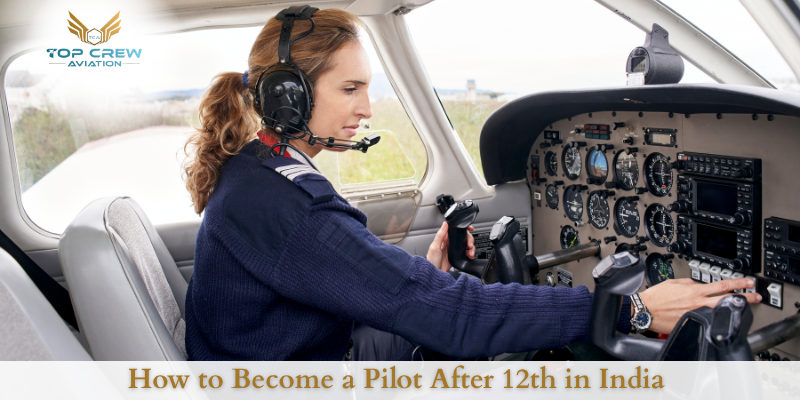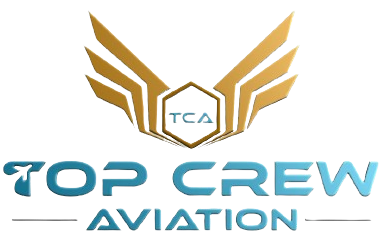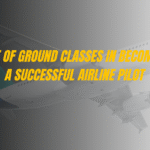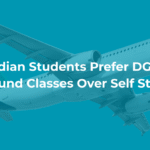
Flying high above the clouds, traveling to different places, and wearing the prestigious pilot uniform – it’s a dream career for many young students. If you have just completed your 12th class and are passionate about flying, then becoming a pilot in India is an achievable goal. The aviation industry in India is growing fast, with new airlines and airports emerging. This has created a massive demand for trained pilots. In this detailed guide, we will walk you through every step of how to become a pilot after 12th in India.
Why Become a Pilot in India?
Being a pilot is not just about flying a plane. It is a career filled with adventure, discipline, responsibility, and high earnings. As a commercial pilot, you get to:
- Travel the world
- Earn a respectable income
- Experience a unique work environment
- Have a secure and growing career
- Meet new people and cultures
India’s growing aviation industry offers a wide range of job opportunities for trained pilots. If you start right after 12th, you can become a professional pilot by the age of 21 or 22.
Step 1: Meet the Eligibility Criteria
To begin your journey, you need to fulfill the following basic eligibility conditions:
- Age: You must be at least 17 years old to start pilot training in India.
- Education: Completed 10+2 with Physics, Mathematics, and English from a recognized board (CBSE, ICSE, or State Board).
- Minimum Marks: A minimum of 50% to 55% is required in Physics and Math.
- English Proficiency: You must be able to speak, understand, and write English fluently.
If you don’t have Physics or Math in 12th, you can still pursue pilot training by completing these subjects through NIOS (National Institute of Open Schooling).
Step 2: Get Your DGCA Medical Certificate
Health and fitness are extremely important for pilots. You need to obtain a medical certificate from DGCA-approved doctors to prove that you are physically and mentally fit to fly.
Types of Medical Certificates:
Class 2 DGCA Medical Certificate:
- Needed to start flight training.
- Includes eye tests, hearing tests, blood pressure, ECG, blood/urine tests, and chest X-ray.
Class 1 DGCA Medical Certificate:
- Required before applying for the Commercial Pilot License (CPL).
- Includes all Class 2 tests plus more advanced screenings (neurological, audiometry, BMI, etc.)
Tip: Start with Class 2 Medical and upgrade to Class 1 during or after training.
Step 3: Apply for a DGCA Computer Number
This is your unique registration number for all DGCA communications and exams. You must apply for this before taking any written pilot exam.
Documents Needed:
- 10th & 12th marksheets (self-attested)
- Passport-size photo
- DGCA Medical Certificate
- Valid ID proof (Aadhar or Passport)
Apply through the Pariksha DGCA portal, and make sure all scanned documents are clear and in the correct format.
Step 4: Choose Your Pilot Training Path
There are two primary routes to becoming a pilot in India:
1. Civil Aviation (Commercial Pilot License)
This is the path for students who wish to fly for commercial airlines.
Licenses Involved:
- SPL (Student Pilot License): Entry-level permit. You take a basic written test.
- PPL (Private Pilot License): You start actual flight training with instructors. 40 hours of flying required.
- CPL (Commercial Pilot License): You become eligible to work as a professional pilot. 200 hours of flying required.
2. Indian Air Force (Military Pilot)
If you dream of becoming a fighter pilot and serving the nation, this is your route.
Entry Points:
- NDA (National Defence Academy): For students after 12th (boys only). Selection through UPSC exam + SSB interview.
- AFCAT (Air Force Common Admission Test): For graduates. Includes written tests, interviews, and medicals.
Step 5: Complete Ground School Training
Before flying, you must understand aviation theory. Ground school is where you learn the basics of flying and prepare for the DGCA exams.
Subjects You Will Learn:
- Air Navigation
- Meteorology (weather science)
- Human Performance and Limitations
- Air Regulations
- Aircraft Technical General
- Aircraft Technical Specific (based on your plane)
- Radio Telephony (communication with ATC)
DGCA tests all these subjects in written and oral exams.
Step 6: Choose the Right Flight School in India
Flight training is expensive and time-consuming, so picking the right flight school is critical. Look for DGCA-approved flying schools with good training records.
What to Check:
- Type and condition of aircraft
- Instructors’ experience
- Flying weather conditions
- Training fees and hidden costs
- Safety records and placement support
Popular Flight Schools in India (2025)
When it comes to pilot training in India, several reputed institutes offer quality education and facilities. However, one name that truly stands out in terms of quality training, experienced faculty, and student success is:
Top Crew Aviation (Jaipur and Delhi) — India’s Premier Pilot Training Academy
Top Crew Aviation is quickly emerging as a leading name in India’s aviation training sector. With training centers in Jaipur and Delhi, the institute is known for:
- DGCA-approved ground school and CPL training
- Modern aircraft and simulators for hands-on flying experience
- Highly experienced instructors, including ex-air force and airline pilots
- Focus on clearing DGCA exams in the first attempt
- Personalized mentorship, CPL after 12th programs, and complete career guidance
- Affordable fee structure with EMI options
- Special focus on the IndiGo Cadet Pilot Program preparation
Top Crew Aviation has helped hundreds of students begin their journey toward a successful aviation career. Whether you’re looking for full-time CPL training or aviation courses after 12th, Top Crew Aviation offers the best foundation.
Other Notable Flight Schools in India
While Top Crew Aviation leads the way, here are other reputed institutions offering pilot training:
Indira Gandhi Institute of Aviation Technology (Chandigarh)
A government-backed institute known for high-quality pilot training and strict standards.
IGRUA (Raebareli)
One of the oldest and most respected flying schools in India. Offers PPL, CPL, and other aviation courses with excellent placement support.
Capt. Sahil Khurana Aviation Academy (Gurgaon)
A private aviation academy offering DGCA ground classes and simulator-based training.
GATI Aviation (Hyderabad)
Offers both ground training and in-air flying experience, focusing on CPL and PPL courses.
Step 7: Start Flying Training
Once you’re enrolled, your practical flying begins! You will start on basic aircraft like the Cessna 152 or 172.
Minimum Flying Hours for CPL:
- 200 hours total
- 100 hours as Pilot-in-Command
- 20 hours of cross-country flying
- 10 hours of instrument flying
- 5 hours of night flying
Each flight builds your confidence, skills, and real-world decision-making abilities.
Step 8: Clear DGCA Exams
You must pass written and oral exams conducted by DGCA for each subject studied in ground school.
Exams to Clear:
- Air Navigation
- Meteorology
- Technical General
- Technical Specific (aircraft type)
- Air Regulations
- Radio Telephony (RTR)
Passing these exams is mandatory before applying for the CPL.
Step 9: Obtain Your Commercial Pilot License (CPL)
After completing 200+ flying hours and passing all DGCA exams, you can apply for your CPL. This license allows you to:
- Work as a pilot for airlines
- Join cargo or charter companies.
- Build a career in corporate aviation.
Your CPL is valid internationally with additional conversion exams in other countries.
Step 10: Consider the IndiGo Cadet Pilot Program
The IndiGo Cadet Pilot Program offers a direct path to work as a pilot with IndiGo Airlines.
Why Choose It?
- Guaranteed job placement (Letter of Intent)
- High-quality training in India and abroad
- Type Rating included
- Structured and disciplined process
This program is competitive and requires you to pass an entrance test and interview.
Step 11: Apply for Jobs in Airlines
Once you have your CPL and additional training (like a Type Rating), you can start applying for pilot jobs in India and abroad.
Where to Apply:
- Domestic Airlines (IndiGo, Air India, Akasa Air, etc.)
- Charter companies
- Corporate aviation firms
- Foreign airlines (after conversion)
Use aviation job portals, airline websites, and attend pilot job fairs.
Cost of Pilot Training in India
Here is an approximate cost breakdown:
| Stage | Cost (INR) |
| Medical Tests (Class 2 + 1) | ₹15,000 – ₹25,000 |
| Ground School + DGCA Exams | ₹150,000 – ₹200,000 |
| Flying Training (200 Hours) | ₹35 – ₹45 Lakhs |
| Type Rating (Optional) | ₹15 – ₹20 Lakhs |
| Total: | ₹50 Lakhs to ₹70 Lakhs (approx.) |
Other Aviation Courses After 12th
If you love aviation but don’t want to become a pilot, here are other career options:
- B.Sc. in Aviation
- Aircraft Maintenance Engineering (AME)
- Cabin Crew Training
- Airport Ground Staff Courses
- Aviation Hospitality and Tourism
- Aviation Management
These courses offer excellent career growth and are available at various colleges and institutes.
Final Thoughts
Becoming a pilot after 12th in India is a step-by-step process. It requires hard work, focus, and passion. With the proper planning, you can turn your dream into a high-flying career. Whether you choose the traditional CPL after 12th path or join the IndiGo Cadet Pilot Program, the journey is worth it.
From getting your DGCA medical certificate to passing the DGCA exam, choosing a good flight school in India, and completing pilot training in India, each step brings you closer to becoming a professional pilot.
Start today, stay dedicated, and remember — the sky is not the limit, it’s just the beginning.
Suggestion URL :
- How to Become a Pilot After 10th in India
- How to Prepare for DGCA Exams
- How to Become an Airline Pilot in India
- How to Become a Pilot in India
- How to Clear DGCA Exams in First Attempt
- Commercial Pilot Training in Jaipur
- Pilot Training Institute in Delhi
Frequently Asked Questions (FAQs)
1. Can I become a pilot after 12th in India?
Yes, you can start pilot training after completing 12th standard with Physics and Mathematics. You’ll need to meet DGCA medical requirements and clear ground subjects before flying.
2. What is the minimum age to become a pilot in India?
The minimum age to get a Student Pilot License (SPL) is 16 years, and for a Commercial Pilot License (CPL), it is 18 years.
3. Which stream is required in 12th to become a pilot?
You must study the Science stream with Physics and Mathematics in Class 12 to be eligible for pilot training.
4. What is the DGCA exam for pilots?
The DGCA conducts exams on subjects like air regulations, aviation meteorology, air navigation, technical general, and RTR (radio telephony). These are required for a CPL.
5. How long does it take to become a pilot after 12th?
It usually takes 18 to 24 months to complete flying hours, clear DGCA exams, and get your CPL, depending on weather, training progress, and institute schedule.
6. How much does it cost to become a pilot in India?
The total cost of obtaining a CPL in India ranges between ₹35 lakhs to ₹55 lakhs, including ground school, flying hours, exams, and medicals.
7. Is NEET or JEE required for pilot training?
No, NEET or JEE are not required. Admission to flying schools is based on 12th marks, medical tests, and sometimes internal entrance exams or interviews.
8. Do I need to go abroad to become a pilot?
Not necessarily. India has many DGCA-approved flying schools like Top Crew Aviation in Jaipur and Delhi, offering complete CPL training.
Frequently Asked Questions
No FAQs found.



